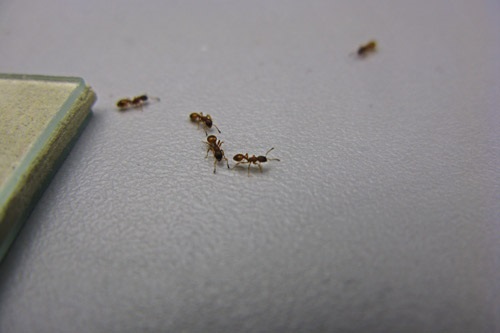Ants employ a few simple and flexible rules to ensure that moving a colony to a new nest does not end in chaos, especially if this is done over some distance. So says Thomas O’Shea-Wheller, lead author of an article .His study indicates that when it comes to giving directions, ants have it down to a fine art.
Researchers often use the house-hunting ant (Temnothorax albipennis) to investigate the migration strategies and behaviour of social insect colonies.
These ants live within rock cavities in a range of environments. They regularly migrate when better lodgings become available, and these may be as close as one centimetre away, or as far as 2.85 meters.
Research has shown that house-hunting ants use so-called tandem running to inform colony members about an imminent move, and to ensure the continuity and speed of the subsequent migration. Tandem running involves one ant that knows the location of a new nest leading an uninformed colony member to it, and sometimes also back again. During this process, one ant teaches another the route to and from the new nest, effectively giving it ‘directions.’ Once a certain number of ants are thus introduced to a new site, a so-called quorum threshold is reached, signalling that the colony has made its decision. After this point, the slow tandem running phase is replaced by the much faster social carrying phase, in which workers transport eggs, larvae and pupae rapidly to the safety of the new nest.
In the present study, O’Shea-Wheller and his colleagues collected 30 colonies of house-hunting ants and allowed them to settle for a week into nests provided under laboratory conditions. Each colony contained a queen, up to 397 workers and up to 56 brood items, including eggs and pupae. During a series of trails, the researchers watched what happened when higher quality empty nest sites were set out at different distances from those occupied by the colonies, in order to induce migrations.
It was found that house-hunting ants will adapt the way that they go about such moves, by regulating their rate of tandem running dependent on the distance that must be traversed to a new dwelling. The further away it is, the more ants will be involved in these runs, and the more back-and-forths ants will make to carry over information about the new location to their uninformed nest-mates. In so doing, the quorum threshold is reached more quickly and the rapid social carrying phase is kick started. This also ensures that as many worker ants as possible are at hand to help during carrying. As such, colonies are able to minimise the transit time, and risk involved, in migrating over longer distances.
According to O’Shea-Wheller, the process occurs in a decentralised fashion and is controlled by basic rules. Specifically, ants respond to the discovery rate of a new nest site, rather than by direct measurement of distance.
“Colonies counteract the difficulty of finding a distant nest, simply by increasing the rate at which individuals give each other ‘directions’,” explains O’Shea-Wheller. “This in turn increases the discovery rate, and contributes to a larger pool of informed workers. As such, the amount of directional information that a colony gathers increases as a function of migration distance, sort of like a self-organising route planner.”
Source: Science daily
N.H.Kh

